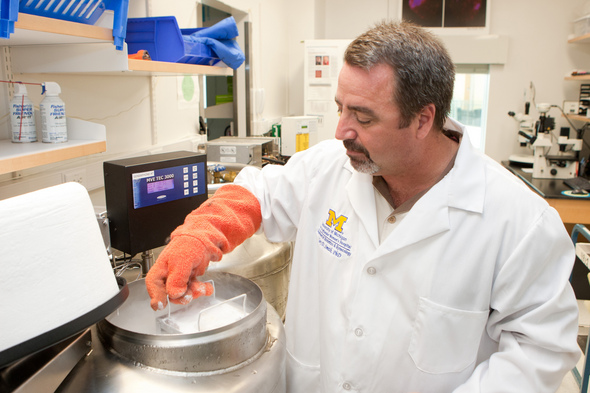University of Michigan scientists create 2 new stem cell lines that could foster research into genetic diseases

Gary Smith removes a rack containing vials that hold frozen human embryos donated to the U-M Consortium for Stem Cell Therapies.
University of Michigan photo
Two human embryonic stem cell lines created in Ann Arbor are among the first to carry genetic defects for specific diseases.
The disease-specific cell lines may help unlock medical mysteries behind the development of hereditary disorders they carry and lead to better treatment options, said Gary Smith, co-director of the University of Michigan Consortium for Stem Cell Therapies and leader of the cell-line derivation project.
One cell line carries the gene for hemophilia B, an inherited condition that prevents the blood from properly clotting. The second has a genetic defect for a neurological condition called Charcot-Marie-Tooth disease, in which muscles in the hand, lower leg and foot slowly degenerate.
“These stem cell lines really are being focused on diseases that affect many people and many families,” Smith said. “Our hope is with these lines we’ll be able to come up with a better understanding of how they develop and then better ways to treat or cure the diseases.”
Drug therapies developed for the conditions could be tested using the human embryonic stem cell lines created at U-M, Smith said.
Researchers will now apply to register the disease-specific human embryonic stem cell lines with the National Institutes of Health, a move that would jump start the potential for further research and federal funding.
There are already three disease-specific lines on the federal registry of 91 human embryonic stem cell lines.
Michigan voters paved the way for the new research, U-M officials say, when in 2008 they approved Proposal 2, which amended the state constitution in order to permit scientists to use surplus embryos from fertility clinics to derive human embryonic stem cell lines, including those tested for genetic diseases.
The university announced the creation of its first human embryonic stem cell line in October 2010. Scientists created it from a 5-day-old embryo that was genetically normal and had been donated after it was no longer needed for reproductive purposes.
A partnership with a Detroit-based company that tests days-old embryos for genetic diseases resulted in the derivation of the latest human embryonic stem cell lines at U-M. Genesis Genetics allows patients with embryos that test positive for genetic disease to donate them to the U-M Consortium for Stem Cell Therapies.
At U-M, plans exist to use donated embryos to create cell lines that carry the genetic markers for conditions like Tay-Sachs, myotonic dystrophy, Huntington's disease, Rett syndrome and spinal muscular atrophy.
Scientists value human embryonic stem cells for their ability to divide in perpetuity and change into any cell type in the human body. A stem cell line is a collection of millions of these genetically identical cells derived from the embryo within several days of its creation. At the time the cells are culled, the embryo is a cluster of about 100 cells.
Juliana Keeping covers general assignment and health and the environment for AnnArbor.com. Reach her at julianakeeping@annarbor.com or 734-623-2528. Follow Juliana Keeping on Twitter


Comments
Dog Guy
Tue, Apr 5, 2011 : 2:17 p.m.
"Create" is a megalomaniacal misnomer. The embryos were cultured or propagated by manipulation, not created.
A2K
Tue, Apr 5, 2011 : 12:33 p.m.
Bravo! Science = +2, Superstitious Mumbo-Jumbo = 0.
John of Saline
Mon, Apr 4, 2011 : 9:10 p.m.
Embryonic stem cells are a subset of stem cells. FYI to those who get confused.
thinker
Mon, Apr 4, 2011 : 8:04 p.m.
Tell the thousands of couples who are trying to get pregnant and can't that these "frozen embryos" are not human babies. There are other stem cells available.
Ricebrnr
Tue, Apr 5, 2011 : 11:57 a.m.
So they should just throw away and otherwise waste this material? Because that's exactly what was going to hppen to these embryos. Once again feelings trump logic. How about we compromise? You find thousands of couples willing to be implanted with the surplus embryos and able to pay for said services and you can have as many of them as you need. You let the scientists have what's left. Fair enough?
bedrog
Mon, Apr 4, 2011 : 8:15 p.m.
ok , if I meet the thousands of couples, i'll be happy to tell them a frozen embryo is not a baby
Terminal
Mon, Apr 4, 2011 : 7:23 p.m.
Let's hope that right wing culture warriors don't get a chance to change the laws regarding stem cell research in Michigan.